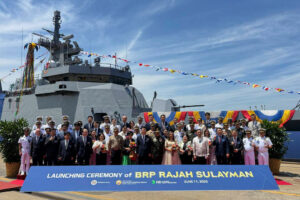
Another ship for PHL Navy launched by HD Hyundai in South Korea

HD HYUNDAI Heavy Industries Co., Ltd. has launched another vessel for the Philippine Navy, the Armed Forces of the Philippines said on Thursday, as Manila expands its naval fleet amid growing tensions in the South China Sea.
Philippine military chief General Romeo S. Brawner, Jr. attended the BRP Rajah Sulayman’s launching ceremonies in Ulsan, South Korea on Wednesday, it said in a statement.
The 93-meter offshore patrol vessel is the lead ship of her class and will be the latest addition to the Philippine Navy’s fleet.
“The launch of… BRP Rajah Sulayman is not merely the unveiling of a new ship; it is a bold declaration of our commitment to maritime security and the defense of our sovereignty,” Mr. Brawner said in the statement.
The ship is the first of six offshore patrol vessels the Philippines ordered from South Korea under a P30-billion deal signed in 2022. It will undergo sea trials and weapon fittings and is expected to be delivered in March next year, according to South Korean Yonhap News Agency.
The offshore patrol vessels would be armed with a 76-milimeter main gun and two 33mm secondary decks, and can carry helicopters and drones on their deck, news website Naval News reported in 2022.
The Philippine Navy took delivery of the BRP Miguel Malvar during a ceremony at the Naval Operating Base in Subic, Zambales province on April 8. The vessel was also built by HD Hyundai Heavy Industries.
The Philippines has increasingly relied on South Korea as a key supplier of defense and military equipment, with the Defense department signing a contract with HD Hyundai Heavy Industries Co., Ltd. to build at least 10 naval ships.
Three missile frigates have been delivered so far.
Manila also recently signed a P39.8-billion contract with South Korea’s Korea Aerospace Industries for the purchase of 12 FA-50 fighter jets.
The Philippines is trying to counter China’s military presence in the region as it pushes back against Beijing’s expansive claims in the South China Sea. It has allotted about $35 billion for military upgrades over the next decade.
China claims nearly all of the mineral-rich waterbody based on 1940s nine-dash line map that overlaps with the exclusive waters of the Philippines and neighbors like Vietnam and Malaysia.
A United Nations-backed tribunal in 2016 voided China’s sweeping claims for being illegal, a ruling that Beijing does not recognize. — Kenneth Christiane L. Basilio



